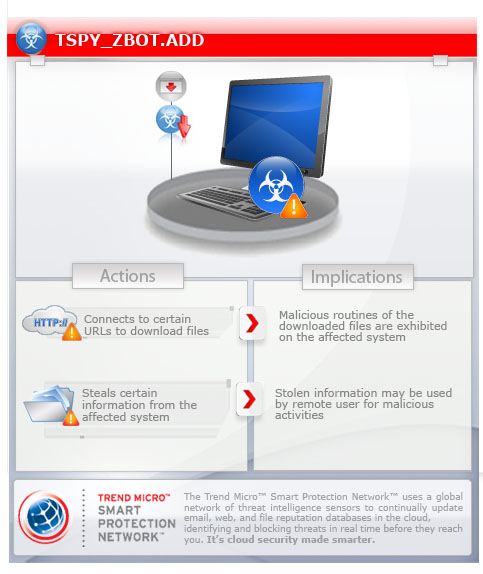TSPY_ZBOT.ADD
PWS:Win32/Zbot.gen!AM (Microsoft), Trojan.Zbot (Symantec), PWS-Zbot (McAfee), W32/Zbot.MZDO!tr (Fortinet)
Windows 2000, Windows XP (32-bit and 64-bit), Windows Server 2003, Windows Vista (32-bit and 64-bit), Windows 7 (32-bit and 64-bit)


Threat Type: Spyware
Destructiveness: No
Encrypted: Yes
In the wild: Yes
OVERVIEW
Downloaded from the Internet
This ZBOT variant was used in a spam run which takes advantage of the UK Tax Return deadline. The said spam message purports to come from HM Revenue and Customs in the UK and informs users of a certain VAT return receipt.
To get a one-glance comprehensive view of the behavior of this Spyware, refer to the Threat Diagram shown below.

This spyware may be downloaded by other malware/grayware from remote sites.
It may create registry entries under a certain registry key.
It deletes the initially executed copy of itself.
TECHNICAL DETAILS
Varies
EXE
Yes
16 Aug 2013
Connects to URLs/IPs, Downloads files, Steals information
Arrival Details
This spyware may be downloaded by the following malware/grayware from remote sites:
- TSPY_FAREIT.ADI
It may be downloaded from the following remote sites:
- http://{BLOCKED}t.{BLOCKED}rara.com/6gsgXBfC.exe
- http://{BLOCKED}lycheezballz.com/sg5bp2.exe
Installation
This spyware drops the following copies of itself into the affected system:
- %Application Data%\{random folder name}\{random file name}.exe
(Note: %Application Data% is the current user's Application Data folder, which is usually C:\Documents and Settings\{user name}\Application Data on Windows 2000, XP, and Server 2003, or C:\Users\{user name}\AppData\Roaming on Windows Vista and 7.)
It creates the following folders:
- %Application Data%\{random folder name}
(Note: %Application Data% is the current user's Application Data folder, which is usually C:\Documents and Settings\{user name}\Application Data on Windows 2000, XP, and Server 2003, or C:\Users\{user name}\AppData\Roaming on Windows Vista and 7.)
It adds the following mutexes to ensure that only one of its copies runs at any one time:
- Global\{GUID}
- Local\{GUID}
It injects threads into the following normal process(es):
- explorer.exe
Autostart Technique
This spyware adds the following registry entries to enable its automatic execution at every system startup:
HKEY_CURRENT_USER\Software\Microsoft\
Windows\CurrentVersion\Run
{random file name} = "%Application Data%\{random folder name}\{random file name}.exe"
Other System Modifications
This spyware adds the following registry keys:
HKEY_CURRENT_USER\Software\Microsoft\
{random}
HKEY_CURRENT_USER\Software\Microsoft\
WAB
It may create registry entries under the following registry key:
HKEY_LOCAL_MACHINE\SYSTEM\CurrentControlSet\
Services\SharedAccess\Parameters\
FirewallPolicy\StandardProfile\GloballyOpenPorts\
List
{random port 1}:UDP = "{random port 1}:UDP:*:Enabled:UDP {random port 1}"
HKEY_LOCAL_MACHINE\SYSTEM\CurrentControlSet\
Services\SharedAccess\Parameters\
FirewallPolicy\StandardProfile\GloballyOpenPorts\
List
{random port 2}:TCP = "{random port 2}:TCP:*:Enabled:TCP {random port 2}"
Information Theft
This spyware gathers the following data:
- Data on cookie files (URLs)
- Email-related information such as account names, email addresses, passwords, server data, and server port
- Email information stored in the user’s Windows Address Book (WAB) file
Other Details
This spyware connects to the following URL(s) to check for an Internet connection:
- http://www.google.com
It deletes the initially executed copy of itself
NOTES:
It attempts to download its configuration file by connecting to randomly generated IP addresses.
The configuration file may contain URLs where it downloads an updated copy of itself and where it sends its gathered information. It may also contain URLs of its target online banking and finance-related sites from where it steals the information.
SOLUTION
9.300
10.220.05
16 Aug 2013
10.221.00
17 Aug 2013
Step 1
Before doing any scans, Windows XP, Windows Vista, and Windows 7 users must disable System Restore to allow full scanning of their computers.
Step 3
Restart in Safe Mode
Step 4
Delete this registry key
Important: Editing the Windows Registry incorrectly can lead to irreversible system malfunction. Please do this step only if you know how or you can ask assistance from your system administrator. Else, check this Microsoft article first before modifying your computer's registry.
- In HKEY_CURRENT_USER\Software\Microsoft
- WAB
- WAB
Step 5
Delete this registry value
Important: Editing the Windows Registry incorrectly can lead to irreversible system malfunction. Please do this step only if you know how or you can ask assistance from your system administrator. Else, check this Microsoft article first before modifying your computer's registry.
- In HKEY_CURRENT_USER\Software\Microsoft\Windows\CurrentVersion\Run
- {random file name} = "%Application Data%\{random folder name}\{random file name}.exe"
- {random file name} = "%Application Data%\{random folder name}\{random file name}.exe"
- In HKEY_LOCAL_MACHINE\SYSTEM\CurrentControlSet\Services\SharedAccess\Parameters\FirewallPolicy\StandardProfile\GloballyOpenPorts\List
- {random port 1}:UDP = "{random port 1}:UDP:*:Enabled:UDP {random port 1}"
- {random port 1}:UDP = "{random port 1}:UDP:*:Enabled:UDP {random port 1}"
- In HKEY_LOCAL_MACHINE\SYSTEM\CurrentControlSet\Services\SharedAccess\Parameters\FirewallPolicy\StandardProfile\GloballyOpenPorts\List
- {random port 2}:TCP = "{random port 2}:TCP:*:Enabled:TCP {random port 2}"
- {random port 2}:TCP = "{random port 2}:TCP:*:Enabled:TCP {random port 2}"
Step 6
Search and delete this folder
- %Application Data%\{random folder name}
Step 7
Restart in normal mode and scan your computer with your Trend Micro product for files detected as TSPY_ZBOT.ADD. If the detected files have already been cleaned, deleted, or quarantined by your Trend Micro product, no further step is required. You may opt to simply delete the quarantined files. Please check this Knowledge Base page for more information.
Step 8
The following created registry key(s) cannot be identified by the user since there are no reference values in the created key. The only way it can be identified is by comparing the present keys with a backup of the system registry. Note that the said key(s) do not have to be deleted since it won't be harmful to the system:
- HKEY_CURRENT_USER\Software\Microsoft\{random}
Did this description help? Tell us how we did.

